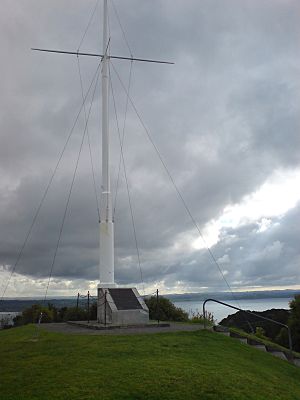Flagstaff Hill (New Zealand) facts for kids
Flagstaff Hill, also called Maiki Hill, is a special place overlooking the beautiful Bay of Islands in New Zealand. It's right next to the historic village of Russell. A flagstaff, which is a tall pole for flying a flag, on this hill played a very important part in the early days of New Zealand. It showed how the local Māori people, especially the Ngāpuhi tribe, and the early British settlers got along – or sometimes didn't!
Contents
Why Was the Flagstaff So Important?
The Treaty and Growing Tensions
After the Treaty of Waitangi was signed in February 1840, things started to get difficult. The Treaty was an agreement between Māori chiefs and the British Crown. However, relations between the Ngāpuhi people and the British (Pākehā) began to worsen.
Hone Heke, a respected local Māori chief, saw the flagstaff flying the Union Jack (the British flag) above the bay at Kororareka (now Russell) as a symbol. For him, it meant that the Ngāpuhi were losing control over their land and way of life.
Why Was Hone Heke Angry?
There were several reasons why Hone Heke was upset.
- The capital of New Zealand had moved from Okiato to Auckland in 1841. This meant less trade and money for the Bay of Islands.
- The government started charging taxes on ships coming into the Bay. This also hurt trade between the Ngāpuhi and foreign traders.
- Some traders even told Heke that the Queen's flag on the flagstaff meant the land was now hers. They said the Ngāpuhi were no longer their own masters. They felt like "taurekareka," which means slaves, to Queen Victoria.
The Flagstaff is Cut Down (Again and Again!)
The flagstaff was first cut down on July 8, 1844. This was done by Te Haratua, a friend of Hone Heke. Heke himself had planned to do it but was convinced not to at the last minute.
The flagstaff was put back up, and soldiers were sent to guard it. But on January 10, 1845, Hone Heke cut it down himself for the second time.
Just eight days later, on January 18, 1845, a new flagstaff was put up. This one was covered in iron to make it stronger. But the very next morning, Hone Heke cut it down again for the third time!
The fourth time the flagstaff was attacked was much more serious. Hone Heke's warriors attacked the guards, and Heke cut down the flagstaff again. At the same time, Te Ruki Kawiti and his men attacked the town of Kororareka. This event marked the beginning of what is now known as the 'Flagstaff War' or the 'Northern War'.
A New Flagstaff, A New Beginning
The war ended in 1846 when Hone Heke and Te Ruki Kawiti made peace with the government. The British government did not put the flagstaff back up right away. They didn't want to cause more fighting.
The flagstaff you see on Flagstaff Hill today was put up in January 1858. This was done by Maihi Paraone Kawiti, who was Te Ruki Kawiti's son. He named the flag "Whakakotahitanga," which means "being at one with the Queen."
As a powerful symbol, the 400 Ngāpuhi warriors who helped put up this new flagstaff were chosen from the groups who had fought against the British. Other Ngāpuhi, who had been allies of the British, watched but did not help. Maihi Paraone Kawiti wanted to show that putting the flagstaff back up was a choice made by the Ngāpuhi themselves. This fifth flagstaff shows that it stands there today because of the good relationship and agreement of the Ngāpuhi people.
Visiting Flagstaff Hill Today
Flagstaff Hill is a popular spot for tourists visiting Russell. There are walking paths that lead up the hill. From the top, you can see amazing views all over the Bay of Islands. The forest around the hill is also home to kiwi birds. However, these birds are very shy, so you probably won't see them during the day.



